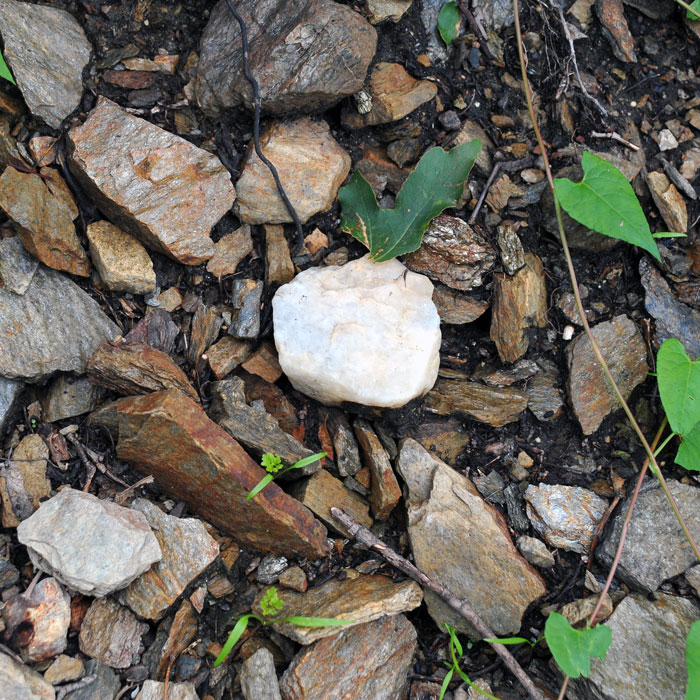
The north of the province of Burgenland is dominated by Lake Neusiedl. On its western shore lies the Leithaberg, a mountain range that shields the region from the cool and humid currents of the Alpine-Atlantic climate.
The winemaking couple Gernot and Heike Heinrich from Gols is representative of many who have migrated from the gentle slopes north of Lake Neusiedl towards the Leithaberg: "Starting in 2006, we leased vineyards there, and today two thirds of our vineyards are on the west side of the lake. We are very fond of the slate and limestone soils because they make a different style of wine possible. Especially the Blaufränkisch likes these soils."
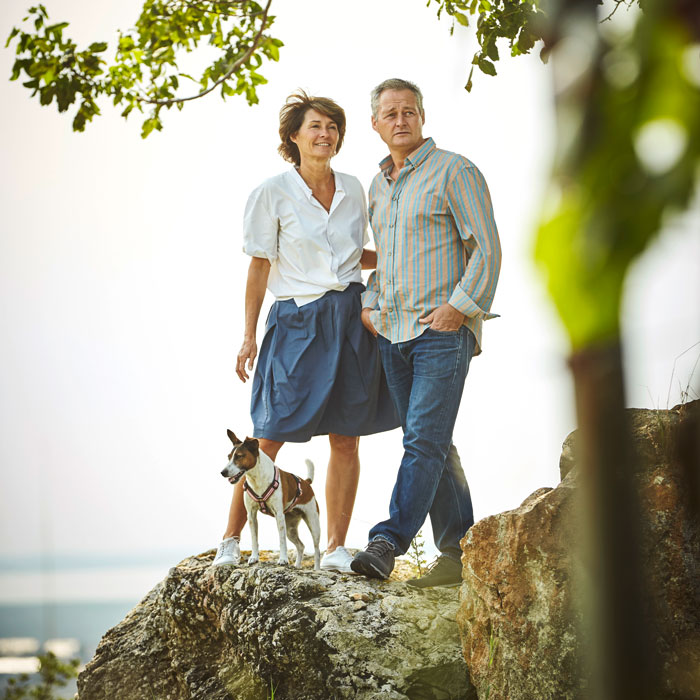
Heinrich, who produces about 50 per cent Blaufränkisch in the biodynamic winery, sees it as the "most exciting red wine variety we have". He emphasises that excellent Blaufränkisch can also grow in the sites near Gols, as many of his colleagues prove. But he also loves the Leithaberg because of its microclimatic differences. "The sites face east or southeast, which means they don't get evening sun. That leads to different aromas. In the final phase of ripening, this is good for Blaufränkisch. The forest on the Leithagebirge does the rest, you feel a distinct cooling in the evening. And the diversity of the landscape is often compared to Burgundy in terms of topography."
Altenberg is almost a monopollage of the Heinrichs. Edelgraben in Breitenbrunn is dominated by slate and was planted in 2008. "On this stony soil I never have young plants growing too fast. So they show terroir character early on. We sometimes harvest only 1,500 kilos from the 6,000 vines per hectare. Each berry weighs only a few grams and has a thick skin. If you don't work gently, the later wine will contain too many tannins. It is important to give the wines time and not to drink them too early. That way you can get more complexity and enjoyment out of it."
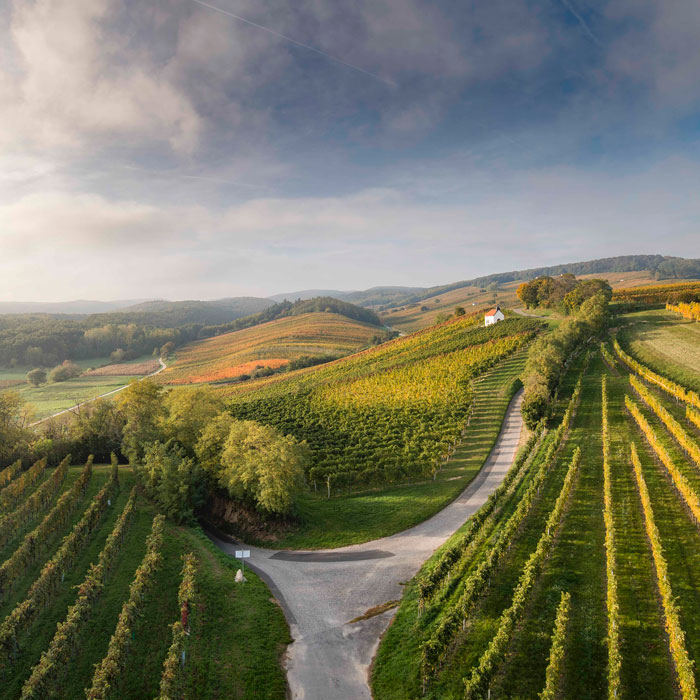
The Rosalien Mountains rise up to 750 metres above sea level along the Lower Austria-Burgenland border. The loess and brown earth soils combined with the Pannonian climate make Blaufränkisch the main variety here.
Mittelburgenland is also known as "Blaufränkischland". It is enclosed like an amphitheatre by three mountain ranges and is only open to the west. Nevertheless, the Pannonian climate influence dominates on the predominantly loamy soils. These store moisture well and protect the vines in hot summers. Best conditions for the grape variety, which predominates here with almost 55 percent.
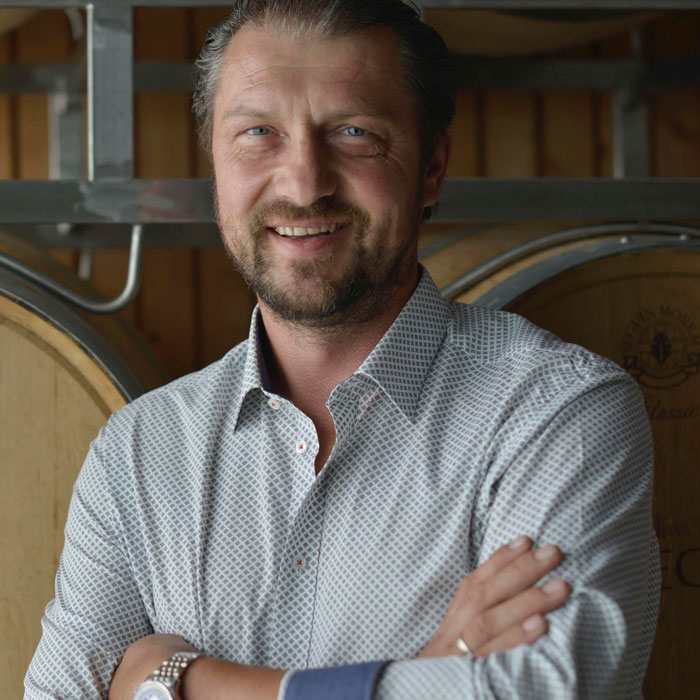
From Deutschkreutz and Neckenmarkt, two of the important towns in the area, it is only a few kilometres as the crow flies to the southern shore of Lake Neusiedl. A particularly beautiful view of it is offered from the Neckenmarkt Hochberg, over which the border to Hungary runs. Deer often enjoy this view, as Georg Wieder from the Juliana Wieder vineyard explains: "In spring they eat the young shoots, in autumn the ripe grapes. Deer, wild boar and birds also like to roam there, so we have to net our vineyards."
Late frosts and increased hailstorms also pose a threat to viticulture. Dry phases are a problem especially for the vineyards on the Neckenmarkt Hochberg, where the mica schist, orthogneiss and shell limestone soils can hardly store any water. On the other hand, this diversity of soils allows for a wide spectrum of Blaufränkisch wines: delicate, finesse-rich, elegant, mineral or also powerful-spicy and salty. For Georg Wieder, an ideal Blaufränkisch from Neckenmarkt is "fruity-spicy, with minerality and structure; ripe tannins, fine acid structure and tannins should be in balance. It is important that the wine unfolds its presence and the wooden barrel only supports in the background".
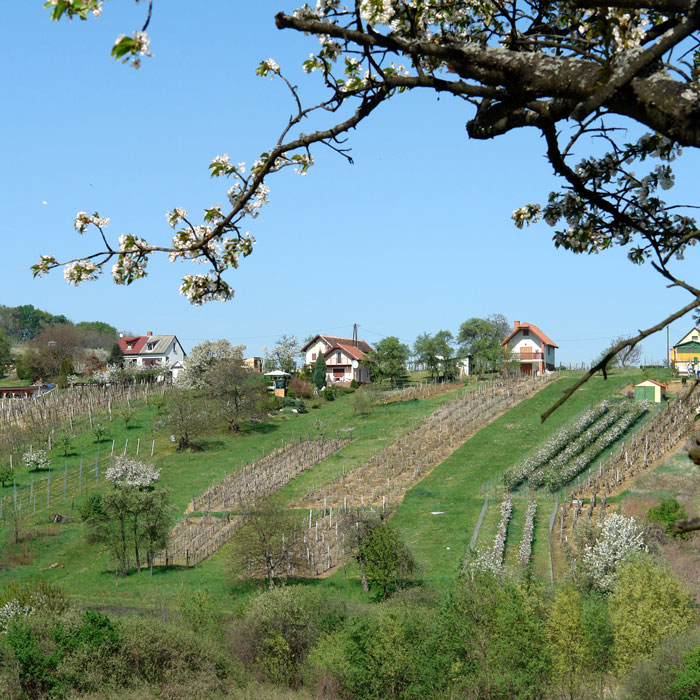
The soils at the eponymous Eisenberg in southern Burgenland are indeed characterised by ferruginous loam and slate, which gives the wines a unique spiciness. The small-structured viticulture in Austria's smallest wine-growing region - with 500 hectares of vineyards even less than Vienna - and the location away from the major traffic routes and centres led to its marketing as a "wine idyll". Yet much has been done in recent years to arouse tourists' curiosity: Nice hotels and excellent restaurants attract more and more interested people. Blaufränkisch actually only plays the main role in the two neighbouring villages Eisenberg an der Pinka and Deutsch-Schützen, otherwise white varieties often still dominate.
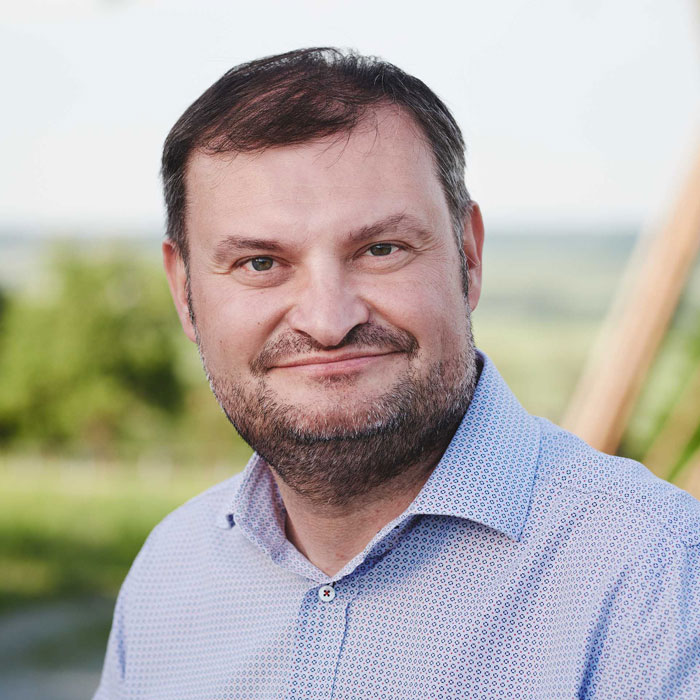
Not least thanks to the efforts of Hermann Krutzler in the 1970s and 1980s, the area formerly known as Südburgenland became more and more associated with Blaufränkisch. His son Reinhold Krutzler is one of the protagonists on the Eisenberg. As in Mittelburgenland, hail, late frosts and drought are the biggest challenges for him on the Eisenberg. Blaufränkisch is his variety of choice: "Our soil characterises it: green and blue slate, iron-rich medium-heavy loam. The variety can handle this particularly well and produces elegant, fine wines with a certain spiciness. When working with wood, it must never mask the character of the grape variety, as was the case 20 years ago. At that time, the focus was on alcohol, colour and a powerful body. It's much more important for us today to focus on the grape variety and the unique soils here at Eisenberg."
 Weingut Ernst Triebaumer
— Burgenland
2019 Ried Mariental Blaufränkisch trocken
57.50 €
Weingut Ernst Triebaumer
— Burgenland
2019 Ried Mariental Blaufränkisch trocken
57.50 €
 Weingut Moric
— Burgenland
2016 Lutzmannsburg Blaufränkisch Reserve trocken Alte Reben
74.50 €
Weingut Moric
— Burgenland
2016 Lutzmannsburg Blaufränkisch Reserve trocken Alte Reben
74.50 €
 schiefer pur
— Burgenland
2015 Süd-Burgenland Ried Reihburg Blaufränkisch trocken "r2"
82.00 €
schiefer pur
— Burgenland
2015 Süd-Burgenland Ried Reihburg Blaufränkisch trocken "r2"
82.00 €
 schiefer pur
— Burgenland
2018 Ried Königsberg Blaufränkisch trocken "Alte Weingärten"
48.00 €
schiefer pur
— Burgenland
2018 Ried Königsberg Blaufränkisch trocken "Alte Weingärten"
48.00 €
 Weingut Krutzler
— Burgenland
2019 Blaufränkisch trocken "Perwolff"
95 WP
great
47.00 €
Weingut Krutzler
— Burgenland
2019 Blaufränkisch trocken "Perwolff"
95 WP
great
47.00 €
 Weingut Heinrich GmbH - Gernot und Heike Heinrich
— Burgenland
2017 Leithaberg DAC Ried Alter Berg Blaufränkisch trocken
94 WP
excellent
50.00 €
Weingut Heinrich GmbH - Gernot und Heike Heinrich
— Burgenland
2017 Leithaberg DAC Ried Alter Berg Blaufränkisch trocken
94 WP
excellent
50.00 €
 Weingut Krutzler
— Burgenland
2017 Eisenberg DAC Ried Weinberg Blaufränkisch Reserve trocken
94 WP
excellent
45.00 €
Weingut Krutzler
— Burgenland
2017 Eisenberg DAC Ried Weinberg Blaufränkisch Reserve trocken
94 WP
excellent
45.00 €
 schiefer pur
— Burgenland
2017 Süd-Burgenland Ried Reihburg Blaufränkisch trocken
58.00 €
schiefer pur
— Burgenland
2017 Süd-Burgenland Ried Reihburg Blaufränkisch trocken
58.00 €
 Weingut Silvia Heinrich
— Burgenland
2017 trocken "Cupido"
63.00 €
Weingut Silvia Heinrich
— Burgenland
2017 trocken "Cupido"
63.00 €
 Weingut Moric
— Burgenland
2018 Blaufränkisch Reserve trocken
32.50 €
Weingut Moric
— Burgenland
2018 Blaufränkisch Reserve trocken
32.50 €
 Weingut Wachter-Wiesler
— Burgenland
2018 Eisenberg DAC Ried Reihburg Blaufränkisch Reserve trocken
49.90 €
Weingut Wachter-Wiesler
— Burgenland
2018 Eisenberg DAC Ried Reihburg Blaufränkisch Reserve trocken
49.90 €
 Weingut Familie Prieler
— Burgenland
2018 Leithaberg DAC Ried Goldberg Blaufränkisch trocken
93 WP
excellent
59.00 €
Weingut Familie Prieler
— Burgenland
2018 Leithaberg DAC Ried Goldberg Blaufränkisch trocken
93 WP
excellent
59.00 €
 Anita und Hans Nittnaus
— Burgenland
2018 Leithaberg DAC Ried Gritschenberg Blaufränkisch trocken
93 WP
excellent
54.00 €
Anita und Hans Nittnaus
— Burgenland
2018 Leithaberg DAC Ried Gritschenberg Blaufränkisch trocken
93 WP
excellent
54.00 €
 Weingut Heinrich GmbH - Gernot und Heike Heinrich
— Burgenland
2017 Leithaberg DAC Ried Edelgraben Blaufränkisch trocken
93 WP
excellent
50.00 €
Weingut Heinrich GmbH - Gernot und Heike Heinrich
— Burgenland
2017 Leithaberg DAC Ried Edelgraben Blaufränkisch trocken
93 WP
excellent
50.00 €
 Weingut Umathum
— Burgenland
2015 Ried Kirchberg Blaufränkisch trocken
42.50 €
Weingut Umathum
— Burgenland
2015 Ried Kirchberg Blaufränkisch trocken
42.50 €
 schiefer pur
— Burgenland
2017 Blaufränkisch trocken "Lutzmannsburg V.V."
48.00 €
schiefer pur
— Burgenland
2017 Blaufränkisch trocken "Lutzmannsburg V.V."
48.00 €
 schiefer pur
— Burgenland
2015 Eisenberg DAC Blaufränkisch Reserve trocken
52.00 €
schiefer pur
— Burgenland
2015 Eisenberg DAC Blaufränkisch Reserve trocken
52.00 €
 Weingut Silvia Heinrich
— Burgenland
2017 Blaufränkisch trocken Alte Reben
55.00 €
Weingut Silvia Heinrich
— Burgenland
2017 Blaufränkisch trocken Alte Reben
55.00 €
 Weingut Familie Strehn
— Burgenland
2018 Blaufränkisch trocken "Roter Schotter"
23.00 €
Weingut Familie Strehn
— Burgenland
2018 Blaufränkisch trocken "Roter Schotter"
23.00 €
 Weingut Wachter-Wiesler
— Burgenland
2018 Eisenberg DAC Ried Saybritz Blaufränkisch Reserve trocken
49.90 €
Weingut Wachter-Wiesler
— Burgenland
2018 Eisenberg DAC Ried Saybritz Blaufränkisch Reserve trocken
49.90 €
 Weingut Lichtenberger & Gonzales
— Burgenland
2018 Ried Vorderberg trocken
51.90 €
Weingut Lichtenberger & Gonzales
— Burgenland
2018 Ried Vorderberg trocken
51.90 €
 Weingut Familie Prieler
— Burgenland
2018 Leithaberg DAC Ried Marienthal Blaufränkisch trocken
92 WP
excellent
56.00 €
Weingut Familie Prieler
— Burgenland
2018 Leithaberg DAC Ried Marienthal Blaufränkisch trocken
92 WP
excellent
56.00 €
 Paul Kerschbaum
— Burgenland
2019 Mittelburgenland Ried Dürrau Blaufränkisch trocken
23.50 €
Paul Kerschbaum
— Burgenland
2019 Mittelburgenland Ried Dürrau Blaufränkisch trocken
23.50 €
 Weingut Tesch
— Burgenland
2015 Blaufränkisch trocken "Patriot"
67.00 €
Weingut Tesch
— Burgenland
2015 Blaufränkisch trocken "Patriot"
67.00 €
 Hammer Wein Rust - Mag. Markus Hammer
— Burgenland
2015 Blaufränkisch Reserve trocken "Rusterberg"
92 WP
excellent
30.00 €
Hammer Wein Rust - Mag. Markus Hammer
— Burgenland
2015 Blaufränkisch Reserve trocken "Rusterberg"
92 WP
excellent
30.00 €
 Weingut Tinhof
— Burgenland
2018 Ried Kirchberg Blaufränkisch trocken "Gloriette®"
48.00 €
Weingut Tinhof
— Burgenland
2018 Ried Kirchberg Blaufränkisch trocken "Gloriette®"
48.00 €
 Anita und Hans Nittnaus
— Burgenland
2018 Leithaberg DAC Ried Jungenberg Blaufränkisch trocken
92 WP
excellent
54.00 €
Anita und Hans Nittnaus
— Burgenland
2018 Leithaberg DAC Ried Jungenberg Blaufränkisch trocken
92 WP
excellent
54.00 €
 Weingut Hans Igler
— Burgenland
2014 Blaufränkisch trocken C11
92 WP
excellent
33.00 €
Weingut Hans Igler
— Burgenland
2014 Blaufränkisch trocken C11
92 WP
excellent
33.00 €
 Weingut Juris
— Burgenland
2017 Ried Ungerberg Blaufränkisch trocken
33.00 €
Weingut Juris
— Burgenland
2017 Ried Ungerberg Blaufränkisch trocken
33.00 €
 Weingut Umathum
— Burgenland
2016 Ried Kirschgarten Blaufränkisch trocken
42.50 €
Weingut Umathum
— Burgenland
2016 Ried Kirschgarten Blaufränkisch trocken
42.50 €
 schiefer pur
— Burgenland
2016 Ried Szapary Blaufränkisch trocken "s"
36.00 €
schiefer pur
— Burgenland
2016 Ried Szapary Blaufränkisch trocken "s"
36.00 €
 Heribert Bayer - Kellerei In Signo Leonis GmbH
— Burgenland
2018 trocken "In Signo Sagittarii"
92 WP
excellent
31.60 €
Heribert Bayer - Kellerei In Signo Leonis GmbH
— Burgenland
2018 trocken "In Signo Sagittarii"
92 WP
excellent
31.60 €
 Weingut Krutzler
— Burgenland
2018 Blaufränkisch trocken "Perwolff"
92 WP
excellent
45.00 €
Weingut Krutzler
— Burgenland
2018 Blaufränkisch trocken "Perwolff"
92 WP
excellent
45.00 €
 Weingut Jalits
— Burgenland
2018 Eisenberg DAC Ried Fasching Reserve trocken
22.00 €
Weingut Jalits
— Burgenland
2018 Eisenberg DAC Ried Fasching Reserve trocken
22.00 €
 Weinbau Straka
— Burgenland
2017 Eisenberg DAC Ried Prantner Blaufränkisch Reserve trocken
35.50 €
Weinbau Straka
— Burgenland
2017 Eisenberg DAC Ried Prantner Blaufränkisch Reserve trocken
35.50 €
 Reumann Josef und Maria
— Burgenland
2019 Mittelburgenland DAC Blaufränkisch Reserve trocken Altes Weingebirge
91 WP
excellent
42.00 €
Reumann Josef und Maria
— Burgenland
2019 Mittelburgenland DAC Blaufränkisch Reserve trocken Altes Weingebirge
91 WP
excellent
42.00 €
 wein.gut wellanschitz
— Burgenland
2019 Blaufränkisch trocken "WELL" Alte Reben
32.00 €
wein.gut wellanschitz
— Burgenland
2019 Blaufränkisch trocken "WELL" Alte Reben
32.00 €
 Weingut Günter Triebaumer
— Burgenland
2019 Ried Plachen Blaufränkisch trocken
43.00 €
Weingut Günter Triebaumer
— Burgenland
2019 Ried Plachen Blaufränkisch trocken
43.00 €
 Brigitte und Gerhard Pittnauer
— Burgenland
2019 Ried Ungerberg Blaufränkisch trocken
34.00 €
Brigitte und Gerhard Pittnauer
— Burgenland
2019 Ried Ungerberg Blaufränkisch trocken
34.00 €
 Weingut Juliana Wieder
— Burgenland
2015 Mittelburgenland DAC Blaufränkisch Reserve trocken
91 WP
excellent
38.90 €
Weingut Juliana Wieder
— Burgenland
2015 Mittelburgenland DAC Blaufränkisch Reserve trocken
91 WP
excellent
38.90 €
 Brigitte und Gerhard Pittnauer
— Burgenland
2018 Ried Ungerberg Blaufränkisch trocken
34.00 €
Brigitte und Gerhard Pittnauer
— Burgenland
2018 Ried Ungerberg Blaufränkisch trocken
34.00 €
 Weingut Tesch
— Burgenland
2017 Blaufränkisch trocken "Patriot"
67.00 €
Weingut Tesch
— Burgenland
2017 Blaufränkisch trocken "Patriot"
67.00 €
 Weingut Esterhazy
— Burgenland
2017 Leithaberg DAC Ried Schildten Blaufränkisch trocken
91 WP
excellent
34.00 €
Weingut Esterhazy
— Burgenland
2017 Leithaberg DAC Ried Schildten Blaufränkisch trocken
91 WP
excellent
34.00 €
 Weingut Gesellmann
— Burgenland
2018 Mittelburgenland Blaufränkisch trocken "hochberc®"
37.80 €
Weingut Gesellmann
— Burgenland
2018 Mittelburgenland Blaufränkisch trocken "hochberc®"
37.80 €
 Weingut Leitner
— Burgenland
2016 Ried Ungerberg Blaufränkisch trocken
90 WP
excellent
30.00 €
Weingut Leitner
— Burgenland
2016 Ried Ungerberg Blaufränkisch trocken
90 WP
excellent
30.00 €
 Weingut Giefing
— Burgenland
2017 Ried Oberer Wald Blaufränkisch Reserve trocken
34.00 €
Weingut Giefing
— Burgenland
2017 Ried Oberer Wald Blaufränkisch Reserve trocken
34.00 €
 Weingut Iby-Lehrner
— Burgenland
2017 Ried Dürrau Blaufränkisch trocken
31.00 €
Weingut Iby-Lehrner
— Burgenland
2017 Ried Dürrau Blaufränkisch trocken
31.00 €
 Weine Thom Wachter
— Burgenland
2018 Eisenberg DAC Ried Fasching Blaufränkisch Reserve trocken
22.00 €
Weine Thom Wachter
— Burgenland
2018 Eisenberg DAC Ried Fasching Blaufränkisch Reserve trocken
22.00 €
 Weine Thom Wachter
— Burgenland
2019 Eisenberg DAC Ried Königsberg Blaufränkisch Reserve trocken
28.00 €
Weine Thom Wachter
— Burgenland
2019 Eisenberg DAC Ried Königsberg Blaufränkisch Reserve trocken
28.00 €
 Weingut Tinhof
— Burgenland
2017 Blaufränkisch trocken "Gloriette"
48.00 €
Weingut Tinhof
— Burgenland
2017 Blaufränkisch trocken "Gloriette"
48.00 €
 Weingut Grenzhof, Bernhard Fiedler
— Burgenland
2019 Leithaberg DAC Ried Goldberg trocken
18.00 €
Weingut Grenzhof, Bernhard Fiedler
— Burgenland
2019 Leithaberg DAC Ried Goldberg trocken
18.00 €
 Bioweingut Moritz (Rotweinbau Moritz)
— Burgenland
2018 Blaufränkisch trocken "NIX"
91 WP
excellent
33.00 €
Bioweingut Moritz (Rotweinbau Moritz)
— Burgenland
2018 Blaufränkisch trocken "NIX"
91 WP
excellent
33.00 €
 Weingut Paul Achs
— Burgenland
2016 Ried Ungerberg Blaufränkisch trocken
42.00 €
Weingut Paul Achs
— Burgenland
2016 Ried Ungerberg Blaufränkisch trocken
42.00 €
 Weingut Jalits
— Burgenland
2018 Eisenberg DAC Ried Szapáry Reserve trocken
14.50 €
Weingut Jalits
— Burgenland
2018 Eisenberg DAC Ried Szapáry Reserve trocken
14.50 €
 Weingut Ernst Triebaumer
— Burgenland
2019 Ried Oberer Wald Blaufränkisch trocken
28.90 €
Weingut Ernst Triebaumer
— Burgenland
2019 Ried Oberer Wald Blaufränkisch trocken
28.90 €
 Weingut Wachter-Wiesler
— Burgenland
2018 Eisenberg DAC Ried Weinberg Blaufränkisch Reserve trocken
32.50 €
Weingut Wachter-Wiesler
— Burgenland
2018 Eisenberg DAC Ried Weinberg Blaufränkisch Reserve trocken
32.50 €
 Weingut Hans Igler
— Burgenland
2011 Mittelburgenland DAC Blaufränkisch Reserve trocken "Biiri"
90 WP
excellent
23.00 €
Weingut Hans Igler
— Burgenland
2011 Mittelburgenland DAC Blaufränkisch Reserve trocken "Biiri"
90 WP
excellent
23.00 €
 Weingut K+K Walter und Irmgard Kirnbauer
— Burgenland
2019 Mittelburgenland DAC Deutschkreutz Blaufränkisch Reserve trocken "Gold Reserve"
21.00 €
Weingut K+K Walter und Irmgard Kirnbauer
— Burgenland
2019 Mittelburgenland DAC Deutschkreutz Blaufränkisch Reserve trocken "Gold Reserve"
21.00 €
 Weingut Franz Schindler
— Burgenland
2019 Leithaberg Ried Lehmgrube Blaufränkisch trocken
23.00 €
Weingut Franz Schindler
— Burgenland
2019 Leithaberg Ried Lehmgrube Blaufränkisch trocken
23.00 €
 Anita und Hans Nittnaus
— Burgenland
2019 Leithaberg DAC Ried Lange Ohn Blaufränkisch trocken
90 WP
excellent
25.00 €
Anita und Hans Nittnaus
— Burgenland
2019 Leithaberg DAC Ried Lange Ohn Blaufränkisch trocken
90 WP
excellent
25.00 €
 Weingut Tinhof
— Burgenland
2018 Leithaberg DAC Ried Setz Blaufränkisch trocken
38.00 €
Weingut Tinhof
— Burgenland
2018 Leithaberg DAC Ried Setz Blaufränkisch trocken
38.00 €
 Grenzlandhof Reumann
— Burgenland
2018 Mittelburgenland DAC Blaufränkisch Reserve trocken
32.00 €
Grenzlandhof Reumann
— Burgenland
2018 Mittelburgenland DAC Blaufränkisch Reserve trocken
32.00 €
 Weinbau Kopfensteiner
— Burgenland
2018 Eisenberg DAC Ried Saybritz Reserve trocken
28.00 €
Weinbau Kopfensteiner
— Burgenland
2018 Eisenberg DAC Ried Saybritz Reserve trocken
28.00 €
 Weingut Juliana Wieder
— Burgenland
2018 Mittelburgenland DAC Ried Bodigraben Blaufränkisch Reserve trocken
90 WP
excellent
Up to 19.90 €
Weingut Juliana Wieder
— Burgenland
2018 Mittelburgenland DAC Ried Bodigraben Blaufränkisch Reserve trocken
90 WP
excellent
Up to 19.90 €
 Rotweine Lang
— Burgenland
2017 trocken Grande Reserve, "V-Max"
38.00 €
Rotweine Lang
— Burgenland
2017 trocken Grande Reserve, "V-Max"
38.00 €
 StephanO DAS-WEIN-GUT
— Burgenland
2017 Eisenberg DAC Ried Fasching Blaufränkisch Reserve trocken
28.00 €
StephanO DAS-WEIN-GUT
— Burgenland
2017 Eisenberg DAC Ried Fasching Blaufränkisch Reserve trocken
28.00 €
 Weingut Josef und Melitta Igler
— Burgenland
2017 trocken "Joe N°1"
33.00 €
Weingut Josef und Melitta Igler
— Burgenland
2017 trocken "Joe N°1"
33.00 €
 Reumann Josef und Maria
— Burgenland
2017 Mittelburgenland DAC Blaufränkisch Reserve trocken
90 WP
excellent
42.00 €
Reumann Josef und Maria
— Burgenland
2017 Mittelburgenland DAC Blaufränkisch Reserve trocken
90 WP
excellent
42.00 €
 Rotweingut Prickler
— Burgenland
2018 Mittelburgenland Blaufränkisch trocken Grande Reserve "V-MAX"
39.00 €
Rotweingut Prickler
— Burgenland
2018 Mittelburgenland Blaufränkisch trocken Grande Reserve "V-MAX"
39.00 €
 Weingut Sommer
— Burgenland
2017 Leithaberg DAC Ried Halser Blaufränkisch trocken
90 WP
excellent
28.00 €
Weingut Sommer
— Burgenland
2017 Leithaberg DAC Ried Halser Blaufränkisch trocken
90 WP
excellent
28.00 €
 Weine Thom Wachter
— Burgenland
2018 Eisenberg DAC Ried Saybritz Blaufränkisch Reserve trocken
22.00 €
Weine Thom Wachter
— Burgenland
2018 Eisenberg DAC Ried Saybritz Blaufränkisch Reserve trocken
22.00 €
 Weine Thom Wachter
— Burgenland
2019 Eisenberg DAC Ried Szapáry Blaufränkisch Reserve trocken "alter garten"
28.00 €
Weine Thom Wachter
— Burgenland
2019 Eisenberg DAC Ried Szapáry Blaufränkisch Reserve trocken "alter garten"
28.00 €
 Weingut Krutzler
— Burgenland
2019 Süd-Burgenland Ried Weinberg trocken "Alter Weingarten"
90 WP
excellent
29.00 €
Weingut Krutzler
— Burgenland
2019 Süd-Burgenland Ried Weinberg trocken "Alter Weingarten"
90 WP
excellent
29.00 €
 Weingut Kollwentz
— Burgenland
2017 Ried Point trocken
90 WP
excellent
51.00 €
Weingut Kollwentz
— Burgenland
2017 Ried Point trocken
90 WP
excellent
51.00 €
 schiefer pur
— Burgenland
2018 Ried Königsberg Blaufränkisch trocken
18.00 €
schiefer pur
— Burgenland
2018 Ried Königsberg Blaufränkisch trocken
18.00 €
 Weingut Krutzler
— Burgenland
2018 Eisenberg DAC Blaufränkisch Reserve trocken
90 WP
excellent
19.50 €
Weingut Krutzler
— Burgenland
2018 Eisenberg DAC Blaufränkisch Reserve trocken
90 WP
excellent
19.50 €
 Bioweingut Moritz (Rotweinbau Moritz)
— Burgenland
2019 Mittelburgenland DAC Ried Hochäcker Blaufränkisch trocken "Handmade"
90 WP
excellent
26.00 €
Bioweingut Moritz (Rotweinbau Moritz)
— Burgenland
2019 Mittelburgenland DAC Ried Hochäcker Blaufränkisch trocken "Handmade"
90 WP
excellent
26.00 €
 Weingut Juliana Wieder
— Burgenland
2011 Mittelburgenland DAC Blaufränkisch Reserve trocken
90 WP
excellent
Up to 35.50 €
Weingut Juliana Wieder
— Burgenland
2011 Mittelburgenland DAC Blaufränkisch Reserve trocken
90 WP
excellent
Up to 35.50 €
Photos: © OEWM WSNA, © Weingut G u.H Heinrich, © R Klaus Gaggl, © Weingut Juliana Wieder, © Egon-Mark , © Weingut Krutzler